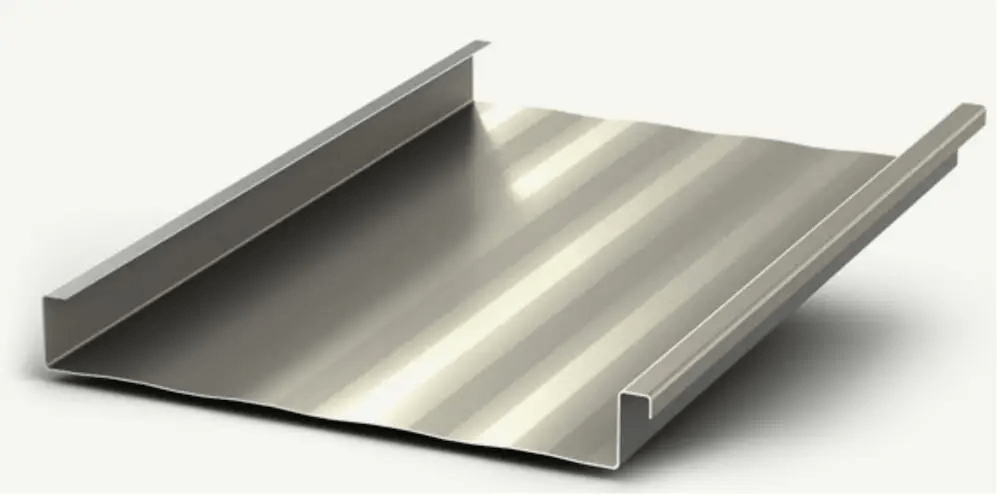A standing seam metal roof is one of the most durable types of metal roofing available, lasting up to 50 years. Unlike traditional metal roof panels which are usually screwed down with exposed fasteners, the fastening on standing seam metal roofs is concealed, which eliminates any possibility of leakage. In addition to its durability, sustainability, and energy efficiency, standing seam systems can also be installed over an existing roof. Let’s explore the pros and cons and the cost of installing a standing seam metal roof and learn what’s best for your home.
How much does a standing seam metal roof cost?

Image source: Saafeld Roofing
You can expect to pay anywhere from $8.50 - $34 per square foot, depending on what materials it’s made of. Standing seam metal roof panels are typically made with either aluminum, galvanized or galvalume steel, or copper and zinc.
Pros and cons of a standing seam metal roof
Image source: Classic Metal Roofing Systems
Pros
Hidden fasteners - One of the biggest advantages to a standing seam metal roof is its hidden fasteners. Most types of metal roofing, like corrugated metal, have exposed screws or fasteners that can wear over time with extreme weather conditions. Because a standing seam metal roof’s fasteners are concealed, it is resistant to UV rays, moisture, and wind.
Durable - Even though standing seam metal is very lightweight and flexible, its concealed fasteners help a standing seam metal roof withstand extreme conditions and increase its lifespan.
Energy-efficient - Standing seam metal roof panels reflect solar radiant heat, keeping your home cool and can reduce cooling costs by 10 to 25%.
Eco-friendly - Standing seam metal roofs are made up of recycled materials like aluminum and can easily be reused.
Rust and fire-resistant - Standing seam panels are sometimes coated with Kynar, a thermoplastic fluoropolymer that prevents the metal from rusting and damaging by harsh weather conditions. Panels coated with Kynar typically feature limited warranties of up to 40 years.
Cons
Expensive - Standing seam metal roofing panels need to be installed by a professional roofer, costing double the amount of a typical asphalt shingle roof and more than other metal roofing materials.
Noisy - If your home isn’t properly insulated, a standing seam metal roof can be noisy when it rains or storms.
Types of standing seam metal roofs

Image source: Powell’s Roofing
Standing seam panels are available in different shapes, depending on the type and size of your roof. The three main types of standing seam metal panels are snap-lock, mechanical, and batten panels. These panel systems are secured to your roof deck with concealed clips or clamps and differentiate in how they are seamed together.
Snap-lock panels

Image source: BCI Metal Roofing
Known for: Ease of installation, affordability, color options
Cons: Not weathertight, not recommended for low-slope roofs
Best for: If you’re on a budget or live in a dryer climate
Lifespan: 30-50 years
Cost: $-$$
Snap-lock panels feature rolled edges with a male and female leg which snap together and attach to the roof deck. These panels are typically the most common type used by contractors due to their low maintenance.
While snap-lock panels have concealed fasteners, they are not as weathertight as mechanical lock panels, making them best suited for dryer climates. The pitch of your roof is also a factor to keep in mind. Snap-lock panels are not well-suited for low-slope roofs because water can accumulate and leak more easily.
Mechanical lock panels

Image source: Union Corrugating Company
Known for: Durability, weathertight seal
Cons: Labor intensive, more expensive
Best for: If you live in a climate with extreme weather conditions
Lifespan: 50 years
Cost: $$-$$$$
Mechanical lock panels are similar to snap-lock ones, except that the edges on these panels are bent and mechanically seamed together either by 90 degrees or 180 degrees. Panels that are mechanically seamed 180 degrees typically require more labor.
These panels are more weathertight than snap-lock panels, making them better for colder climates with snow and hail. The only downside to mechanical lock panels is they require more work to install, increasing the cost.
Batten panels

Image source: Atas International
Known for: Wind resistance, non-traditional roofs
Cons: $-$$$$
Through rollforming, two legs are placed next to each other and a batten clip is drilled to the surface underneath. Then a metal cap is placed over them and is seamed together.
Batten panels are either mechanically seamed or snapped on. When it’s mechanically seamed, batten panels are weathertight and work more efficiently in extreme weather conditions. When it’s snapped on and not properly installed, the batten cap can slide off the seam.
Are standing seam metal roofs worth the money?
While standing seam metal roof systems are more expensive than a traditional asphalt shingle roof, they can last 20-30 years longer and eventually save you more money. Because of its hidden fasteners and seaming panels, standing seam metal roofs require less maintenance than traditional roofing products and can prevent any kind of moisture from damaging the home.
While a standing seam metal roof does usually require a professional installer, they are becoming more popular with homeowners. Contact a trusted roofing contractor today and see if a standing seam metal roof is right for your home.
Chris Gennone is a content specialist and video producer at Fixr.com. He has 5 years of experience writing and editing for a variety of web and print publications, currently specializing in home improvement projects such as roofing, remodeling, and repairs. When Chris isn’t writing or in front of the camera, he’s either playing with his band or tracking down the best sandwich shops.
